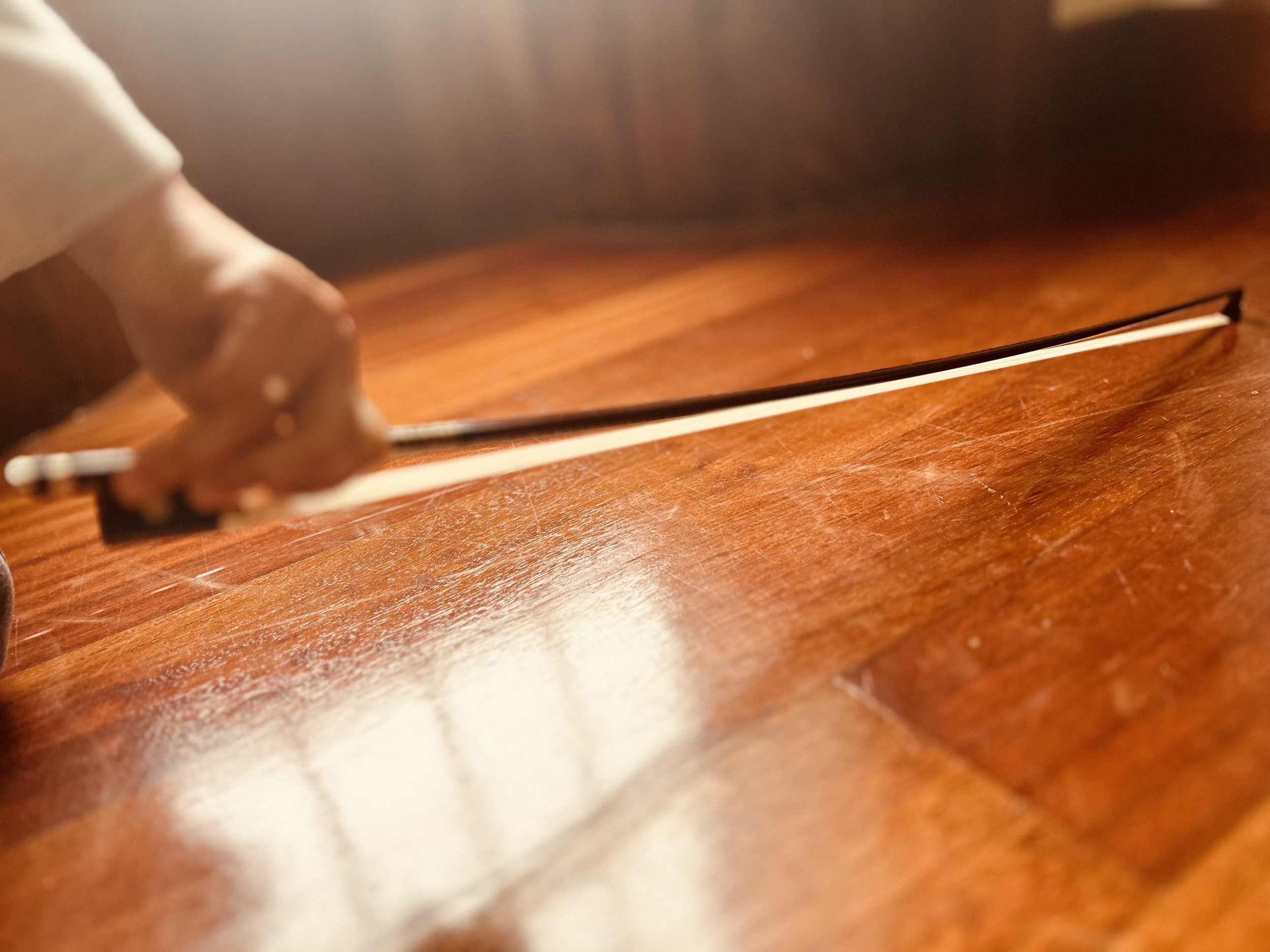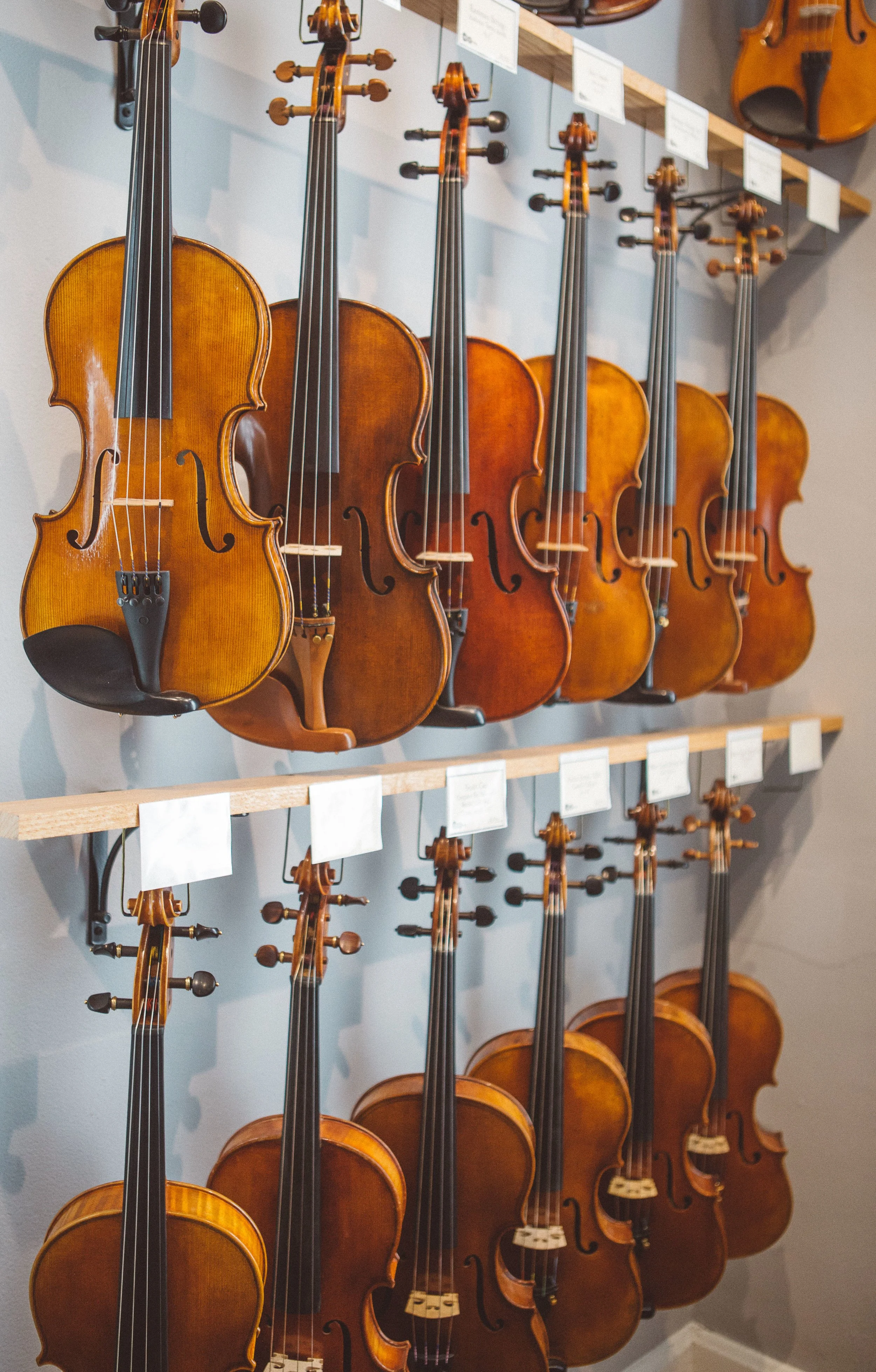CHOOSING THE RIGHT BOW
Choosing the right violin bow is essential for any stringed instrument player. The materials used for bow sticks vary, with carbon fiber and fiberglass being popular choices due to their durability and affordability. Bow balance, stiffness, and responsiveness are important factors to consider, depending on the player's level. Finding the perfect match with your violin is also crucial, and testing the bow in the same playing conditions is recommended. In this article, we will explore the different types of bows for beginner, intermediate, and professional players, as well as carbon fiber, Pernambuco, and alternative bows.
Materials, balance, stiffness and responsiveness
Bow sticks are usually made from wood, such as pernambuco, Brazilwood, and ebony. However, synthetic materials like carbon fiber are becoming increasingly popular due to their durability, consistency, and affordability.
Bow balance is the distribution of weight between the frog (the lower part of the bow) and the tip. Finding the right balance will help with control and technique. Stiffness refers to the amount of resistance the stick has. A stiffer bow is good for playing loud passages, while a more flexible bow is better for soft, delicate passages. Responsiveness is the ability of the bow to respond to quick changes in direction, which is necessary for fast runs and technical passages.
It’s important to choose a bow that complements your violin's sound and style. A good way to do this is by trying out different bow and violin combinations to find the best match. Additionally, consider the level of playing you are at and select a bow that is appropriate for your skill level.
Different bow shapes and their effect on tone
The shape of a bow can have a significant effect on the tone and sound produced by a stringed instrument. Here are some common bow shapes and their effects on tone:
➤ Round bow: a round bow has a circular cross-section and produces a warm, rich tone with a full-bodied sound. It is especially good for playing legato passages and producing a smooth, even sound.
➤ Octagonal bow: an octagonal bow has eight flat sides and produces a brighter tone than a round bow. It is good for playing staccato passages and producing a crisp, articulate sound.
➤ Semicircular bow: a semicircular bow has one flat side and one rounded side, and produces a sound somewhere between the warm tone of a round bow and the bright tone of an octagonal bow. It is especially good for playing chords and producing a well-balanced sound.
➤ Tortoiseshell bow: a tortoiseshell bow produces a warm, rich tone similar to that of a round bow. It is especially good for playing slower, more lyrical passages.
➤ Carbon fiber bow: A carbon-fiber bow produces a bright, powerful tone that is ideal for playing outdoors or in venues with poor acoustics. It is also a durable and affordable option.
Ultimately, the choice of bow shape depends on the player’s personal preference, playing style, and the instrument being played. Experimenting with different bow shapes can help a player find the one that produces the ideal tone and sound for their playing needs.
How to properly test a bow before purchase
Testing a bow before purchasing it is an essential part of choosing the right bow for your instrument and playing style. Here are some tips on how to properly test a bow before making a purchase:
➤ Test the curve: the curve of a violin bow should not be too close to the hair. The proper distance between the hair and the stick is known as the “stick’s camber”, which is the curvature of the stick. If the bow’s curve is too close to the hair, it can cause the hair to become permanently stretched and create a gap between the hair and the stick, which can affect the bow’s playability and sound. On the other hand, if the bow’s curve is too far away from the hair, it can make it difficult to produce a good tone.
➤ Check the bow’s curve: hold the bow horizontally with the hair facing up. Look down the length of the bow from the side to check for any visible signs of curvature or bending. The bow should have a slight curve, known as “camber,” which is necessary for proper playability. A well-made bow should have a balanced and even camber along the entire length of the stick, with a slight curve in the middle that gradually tapers toward the ends.
➤ To test straightness: look at the bow from the tip and frog ends. Hold the bow vertically with the tip up and the frog down. Look down the length of the bow from the tip and frog ends to check for any visible signs of warping or twisting. Use a straightedge to check the straightness of the bow: hold the bow horizontally, hair side up. Place a straight edge, such as a ruler or special bow straightener, along the length of the bow to check for deviations from a straight line. If the bow is straight, it should make contact with the ruler along its entire length. If you notice any significant warping, bending or twisting in the bow, it may be best to avoid purchasing it or have it professionally repaired before using it. A straight, well-balanced bow is essential for the best sound and playability of your instrument.
➤ Check the balance: the balance of a bow is critical to its playability. The balance point is located about one third of the way up the bow from the frog. When held at the balance point, the bow should rest comfortably on the index finger without falling or slipping. The bow should feel comfortable in your hand, not too heavy or too light.
➤ Check the weight: the weight of the bow can affect how it feels in your hand and the sound it produces. A heavier bow can produce a fuller, more resonant sound, but may be harder to control. A lighter bow may be easier to handle, but may not produce as much volume. My preferred weight is 60 g.
➤ Test the flexibility: the flexibility of a bow can affect the tone and response of the instrument. Test the flexibility of the bow by applying pressure to the string and seeing how the bow responds. A good bow should be flexible enough to produce a full sound, but not so flexible that it feels weak or unresponsive.
Flexibility test
➤ The bounce test: hold the bow horizontally, hair down. Place the tip of the bow on a hard surface, such as a music stand, and gently push down on the stick. The bow should flex slightly and bounce back up. The amount of flex and the speed of the bounce will give you an indication of the bow’s flexibility.
➤ The pressure test: play long, sustained notes on each string, gradually increasing the pressure you apply to the bow as you play. A quality, flexible bow will respond to changes in pressure with ease, allowing you to produce a range of dynamic and expressive sounds.
➤ The spiccato test: practice spiccato strokes, in which the bow bounces lightly and quickly off the strings to produce a staccato sound. A flexible bow responds well to this technique, allowing you to produce clear, crisp notes.
➤ The double-stop test: play double-stops, in which two strings are played simultaneously, to test the bow’s flexibility and ability to produce a clear, even tone across multiple strings.
Testing the bow: playing conditions and tips
To test a bow, it’s essential to play in different conditions, such as indoor and outdoor venues. This allows you to see how the bow performs under different humidity, temperature, and lighting conditions. Additionally, try playing different genres of music to get a feel for how the bow performs in different styles. Here are some more tips for testing a bow:
Play long, smooth bows.
Play short, fast bows.
Play multiple notes on one bow stroke.
Play near the frog and then near the tip.
Play with different levels of bow pressure.
Listen to the tone and sound quality.
Beginner bows
When starting out on the violin, it’s important to choose a bow that is appropriate in weight and balance. A lighter bow will be easier to manage at the beginning while you are still developing strength and control. A bow with a good balance point will help to reduce fatigue and make it easier to play in tune. You may also consider purchasing a bow made from synthetic materials in order to keep costs down. Another key factor to keep in mind is the quality of the bow hair. High-quality horsehair will provide good traction against the strings and create a clear, resonant tone. It's also important to make sure that the bow is properly tightened and that the stick is straight.
Intermediate bows
As you progress in your violin playing, you'll want to upgrade to a more sophisticated bow. An intermediate bow should have good playability and a balanced design that supports various playing styles. You may choose a more expensive wooden bow with high-quality horsehair or opt for a carbon fiber bow, which can provide a wider range of sound and projection. It's important to test out different bows before making a decision. Pay attention to how the bow feels in your hand and how it responds to different types of strokes. Look for a bow with good flexibility, control, and responsiveness, as this will allow you to express yourself more freely in your music.
Professional bows
Professional violinists require the best equipment available in order to achieve the highest level of musical expression. A high-quality bow can help to create a warm, nuanced, and powerful sound. Professional-level bows can range from traditional wooden bows to innovative carbon fiber designs. When selecting a professional bow, consider your playing style and the type of music you plan to perform. A silver-mounted bow may have a brighter sound, while a gold-mounted bow may be more mellow. You may also consider various features such as adjustability, weight, and balance. Overall, choosing the right violin bow can be a complex and personal decision. Take your time to explore different options and seek advice from experienced players and professionals. With the right bow in hand, you can improve your playing and create beautiful music.
Carbon fiber bows
When it comes to choosing a violin bow, there are various factors to consider, and one of the most important is the material of the bow itself. Traditionally, the most common materials for bow sticks have been wood, such as Brazilwood and Pernambuco, or more recently, carbon fiber. While each material has its own unique qualities, carbon fiber bows offer several advantages over their traditional wooden counterparts. Firstly, carbon fiber bows tend to be more affordable than high-quality wooden bows. This is because wood is a valuable and rare material, and the best quality wooden bows can cost thousands of dollars, while carbon fiber bows are often available at a more reasonable price point. In addition, carbon fiber bows are more durable than wooden bows. Wooden bows are susceptible to damage from humidity, temperature changes, and general wear and tear, which can affect their sound quality and lifespan. Carbon fiber bows, on the other hand, are resistant to these factors, meaning they can last longer and require less maintenance.
For musicians who frequently travel or perform outdoors, carbon fiber bows offer further advantages. As mentioned, wooden bows are sensitive to changes in temperature and humidity, making them less practical for outdoor use. Carbon fiber bows, however, are resistant to these factors, making them a great choice for musicians who need a reliable and robust bow for performances in different climates and environments. In addition, carbon fiber bows are often lighter in weight than wooden bows, which can make them more comfortable to play for extended periods of time. This is particularly beneficial for musicians who may need to play for hours at a time during rehearsals or performances.
When choosing a carbon fiber bow, there are several factors to consider, such as the weight, balance, and stiffness of the bow. The weight of the bow can affect the sound quality and playability, with lighter bows often being more suitable for fast, technical playing, while heavier bows may provide a richer, more resonant tone. Similarly, the balance of the bow can affect the sound quality and playability, with bows that are well-balanced being easier to control and producing a more even tone across all strings. Finally, the stiffness of the bow can affect the responsiveness and articulation of the sound. A stiffer bow can provide more clarity and definition in the sound, while a more flexible bow can produce a smoother and more expressive sound. Overall, when choosing a carbon fiber bow, it's important to consider your individual needs and preferences, as well as the specific sound qualities you're hoping to achieve. By carefully considering these factors, you can find the perfect carbon fiber bow to complement your violin and enhance your playing.
Pernambuco Bows
Pernambuco bows are made from the wood of the Pernambuco tree found in Brazil. This wood has unique properties that make it an ideal material for violin bows, but it is also rare and increasingly endangered due to deforestation and illegal logging. Because of this, many musicians and bow makers are concerned about the sustainability and ethicality of using Pernambuco wood for bows. Some have switched to other materials, while others have taken steps to ensure that their Pernambuco is sustainably sourced.
If you're set on using a Pernambuco bow, it’s important to get one that is of good quality and not a fake. There are many counterfeit Pernambuco bows on the market that are made from inferior wood or synthetic materials but are sold as genuine Pernambuco. To avoid getting scammed, it’s a good idea to buy from a reputable dealer or luthier who can certify the authenticity of their Pernambuco. You should also look for bows that exhibit certain qualities of good Pernambuco, such as density, stiffness, and a consistent grain pattern.
If you’re not comfortable using Pernambuco or if you can't afford a high-quality Pernambuco bow, there are many other materials available for violin bows, each with its own advantages and disadvantages. Some popular alternative materials include:
Carbon fiber: more durable, more affordable.
Fiberglass: even more affordable than carbon fiber but less responsive
Brazilwood: traditional, warm-sounding wood that is more affordable than Pernambuco but less responsive
Snakewood: a rare and beautiful wood that has a sound similar to Pernambuco but is even more expensive
Makers and experts
➤ Scott Cao: Scott Cao, a renowned violin maker, recommends considering the weight and balance of the bow, as well as the hair tension and length. He also suggests experimenting with different types of rosin to find the right amount of grip and articulation for your playing style.
➤ Dolce violins: at Dolce Violins, experts are available to guide string players in selecting the perfect bow for their needs. They emphasize the importance of trying out different bows in person, as well as considering the level of the player and their budget. Dolce Violins also offers a trade-in program, allowing players to upgrade their bow as their skills progress.
Accessories
In addition to the bow itself, there are a number of accessories that can enhance a string player's performance. Quality cases can protect the instrument from damage during transport, while different types of rosin can affect the sound and playability of the bow. Consider investing in a high-quality case to protect your instrument during travel.Experiment with different types of rosin to find the right balance of grip and tone.
Frequently Asked Questions
-
When buying a violin bow, look for factors such as weight, material, balance, and flexibility. The right bow will complement your playing style and bring out the natural sound of your violin.
-
The two most common materials used for violin bows are pernambuco wood and carbon fiber. Pernambuco bows are considered to be of higher quality, while carbon fiber bows are durable and less expensive.
-
Yes, beginners can use pernambuco bows. However, they can be expensive and not necessary for beginners who are just starting out.
-
Look for a bow that is comfortable and secure in your hand, but not too heavy or too light. The right weight and balance will help you play with precision and ease.
-
A good bow can help produce a range of bow strokes, including legato, staccato, détaché, spiccato, and martelé.
-
A French bow (also called a bow maker) is a type of violin bow that has a slightly curved stick and is held with an overhand grip. It is commonly used in French music and is favored by some violinists for its lightness and flexibility.
-
Wood bows are made from natural materials and are known for their warm and rich sound. Carbon fiber bows are synthetic and can offer a more focused and clear sound. They are also generally more durable and less susceptible to damage from changes in temperature and humidity.
-
A new bow can make a big difference in the sound of your violin. A good bow can help bring out the natural tone and improve the instrument's overall sound quality.
-
Some tips for buying the right violin bow include trying out different bows with your violin, considering your playing style, and seeking advice from experienced professionals and teachers.
-
You can find the perfect bow for your violin by trying out different bows, seeking advice from professionals, and taking the time to find a bow that complements your playing style and brings out the natural sound of your instrument.
Read more articles
Quick video tips
““Ultimately, the choice of bow shape depends on the player’s personal preference, playing style, and the instrument being played.” ”

































